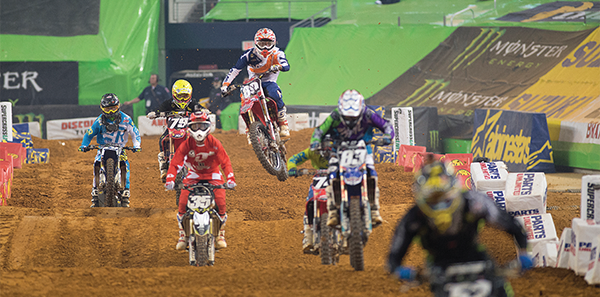
As you might expect, concussions, contusions, and various orthopedic trauma are commonplace during practice and racing sessions. –Dr. Kennedye
Explore This Issue
ACEP Now: Vol 34 – No 10 – October 2015The racers at these events are professional athletes in every sense of the word, and top racers regularly demonstrate aerobic fitness on par with that of any athlete across all sports as measured by the VO2 max. Also, a top racer may have a six- to seven-figure income, and grounding them due to medical injury, a role assumed by the ED docs, is something never taken lightly. As you might expect, concussions, contusions, and various orthopedic trauma are commonplace during practice and racing sessions. However, riders and their crews are often on the road for 30 weeks or more out of the year and have all the typical non-racing-related ailments one might see in the ED on a typical day. If necessary, AMMC physicians are able to function as proxy primary physicians.

Dr. Kennedye keeps a very close eye on the action during the Monster Energy Supercross races. Dr. Kennedye stays on the track during the race to watch the riders and says a hard part of his job is watching out for the inherent dangers of being on the track. Dr. Kennedye keeps an eye on a rider on the back of the Asterisk Medical Mule as he and
Dr. Bodnar transport him off the track and back to the medical center for evaluation.
Most uninitiated people wonder how hard can it be just riding around a track. I’ve played most any sport you can think of, and riding motocross bikes on a track environment is the most aerobically demanding thing I’ve ever done bar none! Every muscle group is firing for 30 to 60 minutes at a time, and you’re constantly subject to forces many times the force of gravity while the bike is trying to throw you on your head. The skills of the pro riders are mind-boggling. Yet despite the speeds and heights attained by the racers, severe, life-threatening injuries are quite rare.
On the Course
During practice or race time, the emergency physicians and other members of the team position themselves trackside, keeping their “heads on a swivel,” monitoring for crashes and injuries while protecting their own safety. Coordination with the promoter and race officials is carried out via headset radio. If an accident occurs and the riders are unable to get up on their own and return to the action or to the pit area, Doc Bodnar and I have at our disposal several “medical mules,” which are converted four-wheel off-road vehicles. After stabilization and immobilization takes place trackside, they will transport the rider back to the AMMC, which is a large two-story 18-wheel rig that essentially functions as a mobile ED. It is equipped with ultrasound, fluoroscopy, slit lamp, and all of the necessary equipment for treatment of fractures, dislocations, and wounds.
Pages: 1 2 3 | Single Page




No Responses to “Emergency Physicians Provide Medical Treatment in Supercross Stadiums”